|
Family: Meropidae (bee-eaters)
Life
> Eukaryotes >
Opisthokonta
> Metazoa (animals) >
Bilateria >
Deuterostomia > Chordata >
Craniata > Vertebrata (vertebrates) > Gnathostomata (jawed
vertebrates) > Teleostomi (teleost fish) > Osteichthyes (bony fish) > Class:
Sarcopterygii (lobe-finned
fish) > Stegocephalia (terrestrial
vertebrates) > Tetrapoda
(four-legged vertebrates) > Reptiliomorpha > Amniota >
Reptilia (reptiles) >
Romeriida > Diapsida > Archosauromorpha > Archosauria >
Dinosauria
(dinosaurs) > Saurischia > Theropoda (bipedal predatory dinosaurs) >
Coelurosauria > Maniraptora > Aves (birds) > Order:
Coraciiformes
Species indigenous to southern Africa
|
Merops albicollis
(White-throated bee-eater) The White-throated bee-eater is a rare vagrant in southern
Africa, as it has only been recorded four times in the region, with sightings in KwaZulu-Natal, Western Cape (two separate records) and the Northern Cape. It
occurs in a band just below the Sahara Desert, from Mauritania to Ethiopia,
extending south to Tanzania, living mainly in semi-desert. |
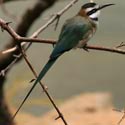 |
|
Merops apiaster
(European bee-eater) The European bee-eater is common in southern Africa, with a
huge worldwide population of 4 million. Its movements are complex, with breeding
populations in the Western and Eastern Capes, and non-breeding populations in
the northern half of southern Africa. It feeds exclusively on insects,
hunting them aerially or from low perches. It breeds in colonies of 20-30,
sometimes 100 pairs, excavating burrows into sandbanks and cliffs. It lays
2-6 eggs, which are incubated by both sexes, for 19-28 days (recorded in
Europe). The chicks stay in the nest for 30-31 days, (recorded in Europe)
after which some will stay to help their parents into the next breeding
season. |
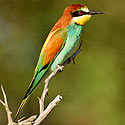 |
|
Merops boehmi (Böhm's
bee-eater) The Böhm's bee-eater occupies two
small areas of south-central Africa, one stretching from western Tanzania to
Zambia and the other stretching from eastern Tanzania to Malawi, barely
touching northern Mozambique, which is the only southern African area it
occupies. It generally prefers open woodland, but it can also be found in
riparian forest and miombo (Brachystegia) woodland. |
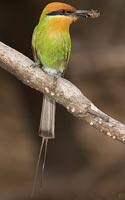 |
|
Merops
bullockoides (White-fronted bee-eater)
The White-fronted bee-eater is endemic to Africa, being found from Gabon and
Uganda south to southern Africa, where it prefers areas with grasslands,
broad-leaved woodland and bushy pastures. It feeds exclusively on insects,
mostly the Apis mellifera (Honey bee) but also bugs, wasps etc. It
has one of the most complicated societies of all birds, with each colony,
which is made up of 10-20 nests dig into riverbanks or gullies.
Colonies comprising a number of groups, known as clans. Within each clan is
a number families, each containing a breeding pair and 1-5 "helpers", which
are usually the previous season's brood. |
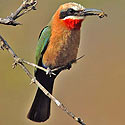 |
|
Merops hirundineus
(Swallow-tailed bee-eater) The Swallow-tailed
bee-eater is occurs in West, East and southern Africa, preferring tall
savanna woodlands and Eucalyptus plantation. It feeds exclusively on
insects, mostly bees, but also wasps, dragonflies, beetles amongst others.
Both sexes excavate the nest, which consists of a short tunnel widening into
an egg chamber. It is usually dug into sandbanks or riverbanks. The female
lays 2-4 eggs, at one day intervals. Very little is known of the chicks,
other than they are fed butterflies, bees and wasps by both sexes. |
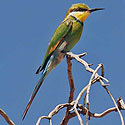 |
|
Merops nubicoides
(Southern carmine bee-eater, Carmine bee-eater)
The Southern carmine bee-eater is found from Tanzania south to Botswana,
Zimbabwe and surrounds, where it occurs mainly in savanna. It feeds
exclusively on insects generally larger than that of other bea-eaters, such
as termite alates, cicadas and locusts. It lives in huge colonies of
100-1000 nests, dug into riverbanks and gullies. The nest is excavated by
both sexes, and consists of a 1-3.5 m long tunnel, ending in an unlined nest
chamber. It lays 1-6 eggs, which are incubated by both sexes, for 11-13
days. The chicks stay in the nest for 11-20 days, and are brooded
continuously by both parents for the whole nestling period. |
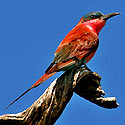 |
|
Merops persicus
(Blue-cheeked bee-eater) The Blue-cheeked
bee-eater is a palearctic breeding migrant, arriving in southern Africa from
October-November, and leaving for its Eurasian breeding grounds in the
period from March-May, mainly April. In southern Africa, it generally
prefers savanna, but it can also be found on open lake shores with reeds,
wooded swamps and bushy grassland. It is insectivorous, usually hawking
insects aerially, but also taking prey from the ground. |
 |
|
Merops pusillus
(Little bee-eater) The Little bee-eater is
probably the most common bee-eater in Africa, with an estimated population
of 60-86 birds! It occurs everywhere in sub-Saharan Africa except the
Lowland forest areas of West Africa, and the western half of southern
Africa, where it mainly lives in savanna. It feeds mostly on bees, as well
as dragonflies, wasps etc. Both sexes excavate the nest, which consists of a
long tunnel, ending in an egg chamber, dug into riverbanks or ditches. It lays 2-6 eggs, which are incubated by both sexes, for 18-20 days.
The chicks stay in the nest for 23-24 days, after which they are dependent
on their parents for several weeks more. |
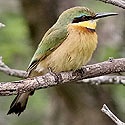 |
|
Merops
superciliosus (Madagascar bee-eater, Olive bee-eater)
The Madagascar bee-eater occupies large areas in Eastern sub-Saharan Africa,
with a smaller population in Namibia and Angola. It prefers open riverine
woodland, coastal plains (especially with mangroves) and wooded swamps - it
is seldom far from water. It is insectivorous, doing most of its foraging in
open areas, hawking insects on the ground and in the air. It lives in
colonies of about 10-30, sometimes even 400 breeding pairs, who dig their
burrows into a riverbank or erosion gully. It lays about 4 eggs, which are
incubated by both sexes. The nestlings stay in the nest for a weeks,
eventually fledging around December. |
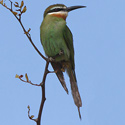 |
|
